A field season in the Rice Lake Plains that was far from plain
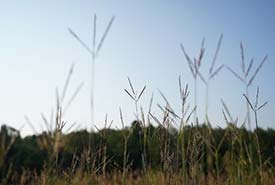
Rice Lake Plains, ON (Photo by NCC)
This past field season spent as a conservation technician with the Nature Conservancy of Canada (NCC) was one to remember. As a soon-to-be graduate of the master's of environmental science program at the University of Toronto, specializing in conservation and biodiversity, I had my eyes set on NCC’s Conservation Internship Program. Through NCC’s internship program, I was able to graduate with an outstanding internship experience. I also applied the skills I gained to complete an Ontario plant taxonomy course, prepare a scientific poster and attend a virtual conference with the University of Toronto while working with NCC.
I have a background and passion for botany, horticulture and conservation science. I was able to perfectly combine all of my interests in a position aimed at restoring Ontario’s most threatened plant community: the tall grass prairie.
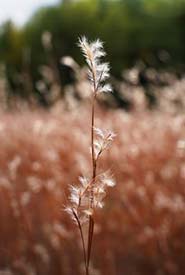
Grasses in tall grass prairies can grow 1.5-2m tall (Photo by NCC)
Tall grass prairies are one of North America’s most diverse and productive ecosystems. They are habitat for some of Canada’s most endangered species and about 20 per cent of Ontario’s rare plants. These unique, fire-dependent ecosystems have grasses that grow to 1.5 to 2 metres tall at maturity. But they remain at less than one per cent of their original range in Ontario, as a result of degradation and destruction due to human development. It is crucial to conserve a network of tall grass communities across the province to protect all of the plant and animal life that depends on them.
During my summer spent restoring tall grass prairies with NCC, I developed quite a fondness for tall grass species, like little bluestem, big bluestem and switch grass. And in the back of my head, I can still hear my colleagues trying to persuade me toward their favourite species. I was part of the Rice Lake Plains (RLP) crew, which was responsible for managing over 800 hectares (about 2,000 acres) of land in central Ontario east. The Hazel Bird Nature Reserve is one project that highlights the tall grass prairie restoration work that I got to be a part of.
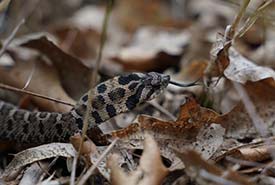
Eastern hog-nosed snake (Photo by NCC)
Hazel Bird Nature reserve contains globally rare habitats, including black oak woodland, black oak savannah and restored tall grass prairie. Grassland birds, species at risk and other rare species, such as eastern hog-nosed snake and eastern meadowlark, depend on these habitats for survival. NCC’s RLP crew has dedicated much of their time to the restoration of these crucial habitats.
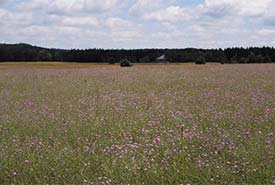
Hazel Bird Nature Reserve before restoration (Photo by NCC)
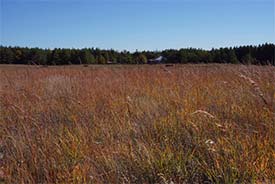
Hazel Bird Nature Reserve after restoration (Photo by NCC)
Originally dominated by invasive knapweed, the Hazel Bird Nature Reserve now displays prairies of switch grass, big bluestem, switchgrass and other tall grass species. By the end of this field season (end of October) at Hazel Bird Nature Reserve and other properties within the Rice Lake Plains, my team and I restored over 30 hectares (74 acres) of tall grass prairie by seeding 185 kilograms of tall grass seed, planting 4,445 native plants and controlling invasive and problem species.
My internship with NCC helped me recognize my strengths and confirm my interest in vegetation and restoration ecology. Some of the skills that I improved and developed include plant identification, knowledge of tallgrass ecosystems, field and planning skills in restoration ecology and scientific report writing. My favourite thing about being an intern with NCC was learning from and working with people who share my passions for conservation and botany.
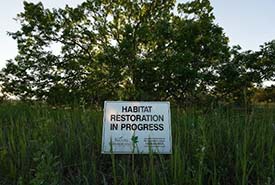
Restoration in progress sign (Photo by NCC)
So what’s next for me? I hope to continue my journey in plant conservation and restoration ecology. I am excited to take on opportunities where I can build upon the skills I developed this summer with NCC. My experience has also inspired me to take on new volunteer roles and to start a social media account dedicated to science communication in field botany and plant conservation. I look forward to seeing what the future holds, having had a great first work experience in the world of conservation.
This internship position and NCC’s work to restore tall grass prairie in the Rice Lake Plains in was generously funded by the Ontario Trillium Foundation and other donors.

